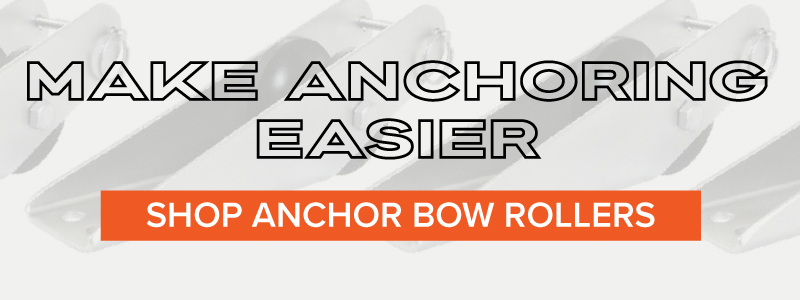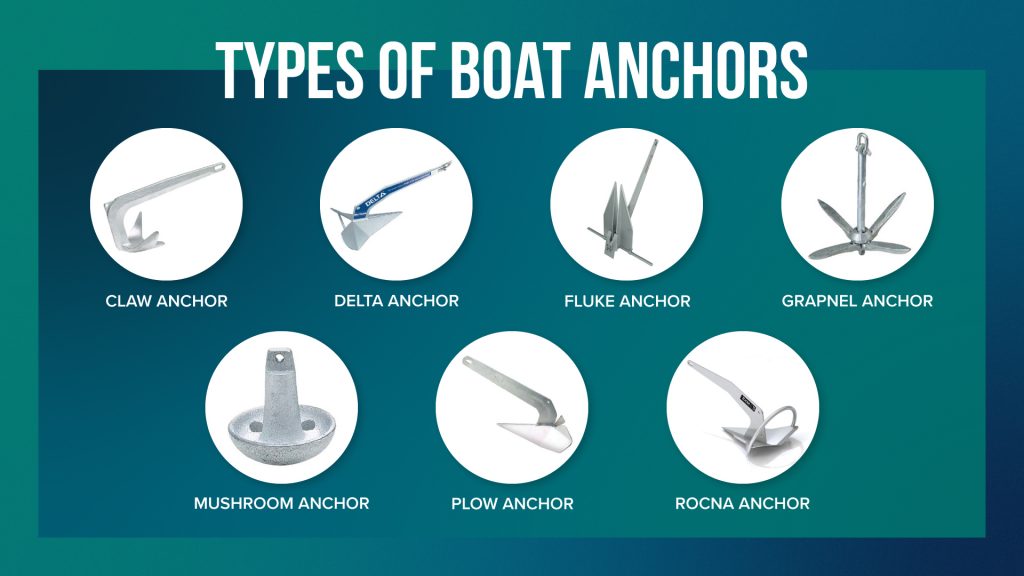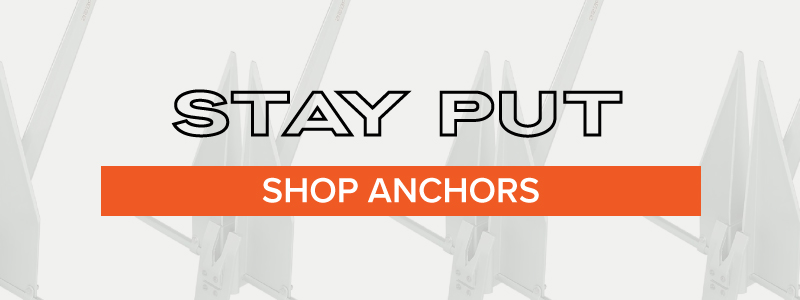The Basics of Anchoring a Boat
Understanding the basics of anchoring your boat is fundamental to safe and responsible boating. Learning to anchor your boat properly will help ensure that you stay in place for recreational activities, but it’s also essential for keeping your boat safe and secure in a wide variety of other situations.
Anchoring your boat correctly can keep you from drifting and protect you from potential hazards. However, the process of proper anchoring can seem daunting and often overwhelming. Proper anchoring considers many issues, like choosing the best anchor for your boat or understanding how to set an anchor.
In this guide, we’ll systematically explain the basics of anchoring, from anchoring terms to retrieving anchors properly. Read on for detailed information that you’ll need to be ready to anchor your boat like a pro.
Where and When to Drop Anchor
Anchors are a critical component of a safe and successful boating experience. Anchors play a crucial role in securing vessels in various scenarios. In addition to providing stability and positioning for recreational purposes, they are essential safety equipment.
Here are some specific situations when dropping anchor is important:
- Fishing: When you’ve found the perfect spot and don’t want to drift off of it, an anchor will keep you in place and allow you to focus on fishing rather than managing your boat.
- Swimming: An anchor can help keep your boat in place and prevent it from floating away while you enjoy time on the water at your favorite swimming hole.
- Recreational activities: Whether you’re soaking up the sun or having a picnic on a sandbar, an anchor can keep your boat securely in place.
- Diving: When scuba diving or snorkeling, an anchor is essential for staying in position and keeping you close to your intended dive site.

Anchoring isn’t just about convenience and enjoyment. It’s also an important safety measure. In the event of engine failure or unexpected weather, an anchor can prove to be a lifesaver by holding your boat in place, protecting it from potential damage, and even saving lives.
A Guide to the Different Types of Boat Anchors
Choosing the right anchor for your boat is essential for a successful and safe boating experience. Check out the following review of the various anchor types, each with unique characteristics.
- Claw: The claw anchor is versatile and practical in various conditions, including rocky or coral bottoms.
- Delta: Popular for medium-sized boats, the delta anchor is known for its holding strength and quick-setting properties.
- Fluke: Fluke anchors, also called Danforth anchors, are ideal for sandy or muddy bottoms due to their lightweight construction. We highly recommend Fortress and Guardian anchors for those seeking a more heavy-duty option. Fortress anchors are set apart from typical Danforth anchors in significant ways. Since Danforths are two-piece, welded anchors, they are susceptible to breakage. Alternatively, Fortress anchors are made with no welds in the entire design. So, they are built to withstand the rigors of usage without breaking.
- Grapnel: Grapnel anchors are useful for small boats or as secondary anchors. Multiple hooks for a secure hold characterize the grapnel anchor.
- Mushroom: Mushroom anchors are most suitable for soft, muddy bottoms. A compact mushroom anchor is easy to transport and store. Mushroom anchors are popular with kayakers.
- Plow: Plow anchors are a traditional style and an excellent choice for larger boats and rough waters, with the ability to dig deep into the bottom for a secure hold.
- Rocna: The modern Rocna design combines the best features of a plow and fluke anchor for superior holding power and reliability.
By understanding the strengths and weaknesses of each type of anchor, you can choose the best one for your boat and make sure that your trip is successful and safe.

Basic Anchoring Terms
The following is a sample of relevant anchor terms and terminology:
- Anchor aweigh: When the anchor lifts off the seabed, and the boat is free to move.
- Chain locker: The compartment where the anchor rode is stored when not in use.
- Crown: The top part of the anchor where the shank and fluke attach.
- Dragging: When the anchor fails to hold, and the boat moves.
- Fluke: The part of the anchor that digs into the seabed.
- Hawsepipe: The hole or tube in the bow of the boat where the anchor rode passes through.
- Lunch hook: Smaller anchor for temporary anchoring during short stops.
- Rode: The line or chain that connects the anchor to the boat.
- Scope: The ratio of the length of the anchor rode to the depth of the water. Ideal scope ratios are related to the type of anchor being used.
- Set: The process of the anchor taking hold and digging into the seabed.
- Shank: The long, vertical part that extends down into the seabed.
- Storm anchor: Anchor with high holding power and larger size than a working anchor, used in severe weather conditions.
- Swing circle: The area in which the boat swings around the anchor.
- Windlass: A machine used to raise and lower the anchor and its rode.
- Working anchor: Primary anchor for regular anchoring in normal weather conditions.
- Yawing: When the boat swings back and forth at anchor due to wind or current.

How to Choose the Right Anchor for a Boat
Choosing the right anchor for a boat is crucial for secure and safe anchoring.
The following factors are relevant considerations for selecting an anchor:
- Boat size and weight: The anchor must be appropriate for the boat’s size and weight.
- Bottom composition: Different types of anchors work better on different bottom compositions, such as sand, mud, or rock.
- Weather and wind conditions: Take into account the expected weather and wind when selecting an anchor.
- Holding power: The anchor must have enough holding power to keep the boat in place.
By carefully considering the factors above, boaters can make informed decisions to choose a suitable anchor for their vessel to optimize their chances for safe and secure anchoring in various conditions.
How Scope Calculation Relates to Anchor Usage
Scope calculation is an essential factor to consider when using an anchor. A proper scope ensures that the anchor correctly sets and provides sufficient holding power to keep the boat in place. The recommended scope ratio varies depending on the type of anchor used and the conditions in which it will be used.
By accurately calculating the proper scope and ensuring a sufficient length of anchor rode is released, boaters can effectively maintain the holding power of their anchor, keeping their vessel safe and secure.
Where to Drop Anchor: Key Considerations
When selecting the optimal location to drop anchor, consider these factors to achieve a safe and secure anchorage while minimizing environmental impact:
- Depth: Opt for a location with suitable water depth, accommodating your vessel’s draft and allowing for tide changes.
- Seabed composition: Seek a sandy or muddy bottom for better anchor holding while avoiding environmentally sensitive coral reefs.
- Swinging room: Ensure enough space for your boat to swing with the wind and tide without colliding with nearby vessels or obstacles.
- Shelter: When possible, select a location offering protection from prevailing winds, waves, and weather conditions.
- Navigational hazards: Avoid anchoring near shipping channels, cables, or other hazards marked on nautical charts.
- Local regulations: Familiarize yourself with any anchoring restrictions or requirements in the area, including those aimed at protecting coral reefs and other sensitive ecosystems.

The Proper Way to Set a Danforth or Fortress Anchor: A Step-by-Step Guide
- Assess Your Surroundings: Knowing your surroundings is critical before you drop anchor. Paying attention to what’s around the boat will help you determine the amount of anchor line you need to use and calculate the appropriate scope.
- Head into the Current: Position the bow of your boat into the current. Proper positioning will help slow down the boat and give the anchor more time to set correctly.
- Drop Anchor: Once you’re in the correct position, drop the anchor into the water. Allow the current to pull you back until you feel the anchor catch.
- Slowly Reverse: After you feel the anchor catch, slowly put the vessel in reverse to help the anchor dig into the seabed and set securely.
Pro Tip: The Importance of Anchoring from the Bow of the Boat
Anchoring from the bow of a boat is a fundamental practice, and for a good reason. The bow is the best place to anchor because it provides better control and stability and easier access to the anchor when it’s time to retrieve it.
By following these steps, you can correctly set your Danforth or Fortress anchor properly and keep our vessel protected and stable while you enjoy your time on the water.
When to Use Two Anchors to Hold a Boat
There are instances when having more than one anchor may be necessary, like holding a boat on a sandbar or managing a vessel during a storm. For sandbars, one anchor is needed on the bow and one on the stern, with the stern anchor walked out and the bow anchor set. In storm situations or when there is potential for swinging into other boats or structures in the water, a Bahamian mooring with one anchor on the bow and one on the side may be required.
Pro Tip:
An extra storm anchor on your boat is crucial for safety and preparedness. A secondary storm anchor provides added security and stability in extreme weather conditions or unexpected situations.
How to Retrieve an Anchor: Step-by-Step Guide
- Approach the anchor location: Navigate your boat toward the position where you initially set the anchor.
- Position your boat above the anchor: Ensure your boat is directly above the anchor point to avoid any lateral force.
- Pull up the anchor: Carefully and steadily, pull the anchor straight up. Avoid pulling a Danforth or Fortress anchor from the side, as this can cause damage.
Anchors Away: Final Thoughts
In conclusion, understanding the fundamentals of boat anchoring is essential for any boater. With a firm grasp of the various types of anchors, their appropriate usage, and the step-by-step anchoring process, boaters can confidently and safely secure their vessels in a range of conditions.
As we have explored, a proper anchoring technique prevents damage to the boat and the surrounding environment and ensures a comfortable and enjoyable experience on the water. Implementing these basic anchoring principles, boaters can confidently spend time on the water, knowing their vessel is well-anchored and secure.
The post The Basics of Anchoring a Boat appeared first on PartsVu Xchange.
